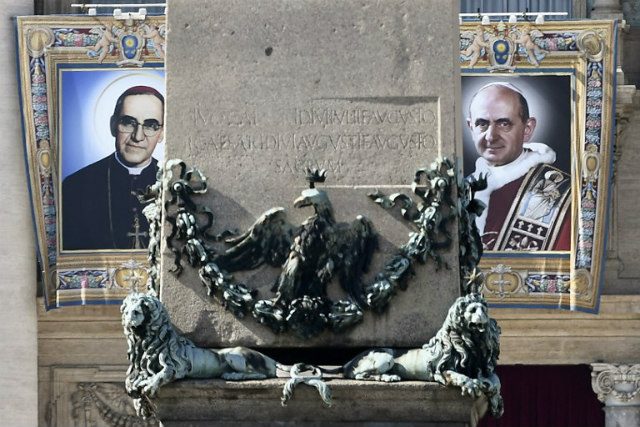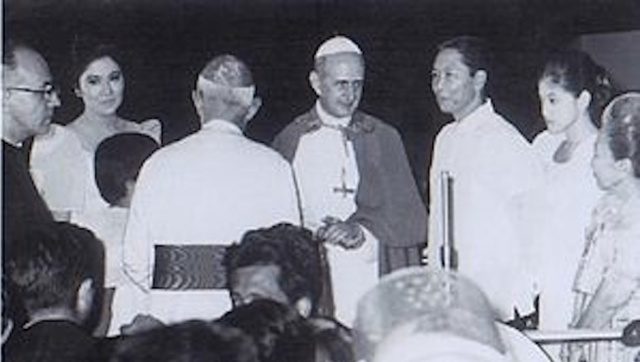SUMMARY
This is AI generated summarization, which may have errors. For context, always refer to the full article.

MANILA, Philippines (UPDATED) – Paul VI, who was the first pope to visit the Philippines, and martyred Archbishop Oscar Romero of El Salvador were declared saints on Sunday, October 14, in a ceremony led by Pope Francis.
Paul VI visited Manila from November 27 to 29, 1970, under the watch of then president Ferdinand Marcos.
During his 3-day trip to the Philippines in 1970, Paul VI said Mass at the Manila Cathedral and at the Quezon Memorial Circle, and also visited poor families in Tondo, Manila.

The late pope is remembered for reaffirming the Catholic Church’s ban on contraception, and for concluding the Second Vatican Council or Vatican II, which sought to reform the Catholic Church.
Romero, on the other hand, was the archbishop of El Salvador who fought for the poor and was eventually assassinated while saying Mass in 1980.
In recent months, Catholics in the Philippines haved remembered Romero’s example after unidentified assassins killed at least 3 Filipino priests, one of them after saying Mass.
Sunday ended the journey to sainthood of Catholic giants Paul VI and Romero.
60,000 pilgrims, heads of state attending
On this day, Pope Francis wore a blood-stained rope belt which belonged to Romero, who was murdered at the altar, as he led the ceremony in front of some 60,000 pilgrims and heads of state from across the world.
The pontiff also used a chalice and pastoral staff belonging to Paul VI in a canonization being seen as a reminder of Francis’s call for “a poor church for the poor.”
Both men have been hailed by Francis for their courage in turbulent times and their dedication to social justice and the downtrodden.
Their giant portraits were unfurled on Saint Peter’s Basilica along with those of 5 other new saints, including an orphaned youth and a German nun.
Romero stood up for peasant rights in the face of a right-wing backlash which painted him as a radical supporter of “liberation” theology in his small, impoverished central American nation.
His radio sermons condemning government repression came to be heard throughout the land.
On March 24, 1980, the man dubbed the “voice of those without voice” was shot in the heart, killed by a single bullet as he prepared communion at the start of a bloody civil war which claimed some 75,000 lives.
Heavy opposition
For a long time, efforts to recognize Romero met with heavy opposition from conservative Catholics and the Salvadoran right, who saw veiled Marxism in his sermons.
Others said he had been killed for political rather than religious reasons and therefore should not be considered a Catholic martyr.
“It was like a dagger to the heart. I received threats,” Archbishop Vincenzo Paglia, the man tasked with guiding the canonization process, told the Jesuit weekly America.
But Francis — the first Latin American pope — beatified him as a “martyr” in 2015 to popular acclaim after his predecessor, the retired Benedict XVI, championed his cause for canonization.
It was Benedict who also extolled Paul VI, a man he once described as “almost superhuman”.
Paul VI — who encouraged Romero in his struggle — was the first head of the Roman Catholic Church to attempt to reform the Vatican’s powerful and unruly Curia, a challenge Francis also decided to take on.
He was also famously the first to reject the papal trappings of luxury, setting aside the traditional papal tiara — a jewel-encrusted, three-tiered, conical crown — shortly after his election in 1963 and donating its value to the poor.
It was a gesture echoed by Francis, who renounced the papal apartment and gold cross. (READ: Pope Francis known as champion of poor)
‘Brave Christian’
The softly-spoken Giovanni Battista Montini was elected pope in 1963 in a difficult period for the church, which lost many believers as populist rebellions swept across the West.
He completed the reforms of the Second Vatican Council and was the first pilgrim pope, crossing continents on his trips to meet the faithful.
At his beatification mass, Francis had hailed him a “brave Christian”.
But he was also hampered by a reputation for being weak and overly cautious.
He is most famous for reaffirming the church’s ban on contraception — despite the fact that his own advisory commission voted overwhelming to lift the prohibition.
The decision enraged many Catholics at a time of sexual freedoms, with women demanding the right to use the birth control pill. – with reports from Agence France-Presse/Rappler.com
Add a comment
How does this make you feel?
There are no comments yet. Add your comment to start the conversation.